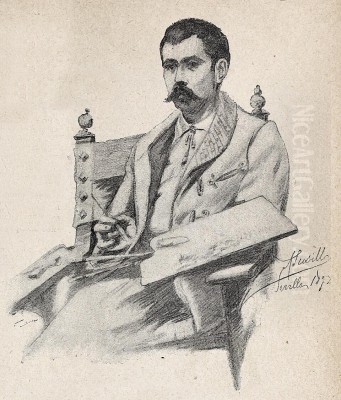
Manuel García y Rodríguez stands as a significant figure in the landscape of Spanish art, particularly celebrated for his evocative depictions of Andalusia during the late 19th and early 20th centuries. Born in Seville in 1863 and passing away in 1925, his life spanned a period of rich artistic development in Spain. He dedicated his career primarily to landscape painting, using oils to capture the unique light, atmosphere, and scenery of his native region, leaving behind a legacy of works cherished for their realism, detail, and profound sense of place.
Seville's Son: Identity and Beginnings
Manuel García y Rodríguez was intrinsically linked to Seville, the city of his birth. This vibrant Andalusian capital, with its rich history, distinctive architecture, and surrounding natural beauty, would become the primary muse for his artistic endeavors. Unlike some artists whose formative years are meticulously documented, specific details about García y Rodríguez's formal artistic training or particular mentors remain scarce in historical records. The available information suggests he developed his skills through practice, observation, and association with fellow artists rather than through a structured academic path at a specific institution.
It is critically important to distinguish Manuel García y Rodríguez, the painter, from other notable individuals with similar names to avoid historical confusion. He is not Manuel Patricio García (1805-1906), the world-renowned Spanish baritone, influential singing teacher, and inventor of the laryngoscope, despite some sources occasionally conflating their identities. The painter's life and work were firmly rooted in the visual arts, specifically the landscapes of southern Spain. He is also distinct from other historical figures named Manuel Rodríguez, such as the Chilean lawyer and guerrilla leader prominent during their independence movement. Our focus remains solely on the Sevillian painter born in 1863.
The Andalusian Muse: Subject and Scenery

The heart of García y Rodríguez's oeuvre lies in his deep connection to Andalusia. He was drawn to the diverse landscapes offered by this southern Spanish region, returning time and again to capture its essence on canvas. His favoured subjects included the bustling port of Seville, the serene banks of the Guadalquivir River – the great river that flows through the region – and the picturesque surroundings of towns like Alcalá de Guadaíra and Sanlúcar de Barrameda.
He possessed a keen eye for the beauty found in both grand vistas and intimate corners. His paintings often explore the interplay between nature and human presence, depicting orchards, gardens like those of the Alcázar of Seville, quiet courtyards, and pathways winding through the countryside, such as those found in the Oromana area near Alcalá de Guadaíra. He seemed particularly fascinated by the quality of light in Andalusia, capturing its effects on water, foliage, and architecture with remarkable sensitivity. This dedication to his local environment makes his work a valuable visual record of the region at the turn of the 20th century.
A Realistic Vision: Style and Technique
García y Rodríguez's artistic style is firmly rooted in Realism. He approached his subjects with a commitment to accurate representation, employing meticulous brushwork and a sharp focus on detail. His works are characterized by their clarity and precision, demonstrating a profound observational skill honed through direct engagement with the landscape. He excelled at rendering textures – the roughness of stone, the softness of foliage, the reflective quality of water – bringing a tangible quality to his scenes.
His handling of light and shadow was crucial to his technique. He masterfully depicted the strong Spanish sunlight and the cool, contrasting shadows, creating depth and volume in his compositions. While predominantly realistic, his work sometimes carries undertones of late Romanticism or Costumbrismo (a Spanish genre focusing on local customs and manners), particularly in his choice of picturesque scenes and the occasional inclusion of figures that add life and narrative interest to the landscape. This technique of creating "composite landscapes," carefully arranged scenes often populated with typical local figures, proved highly popular with audiences, especially the burgeoning middle class of the era.
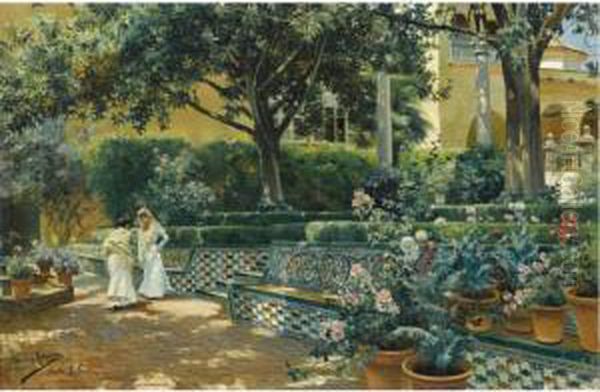
Sources note his adeptness at using cooler tones for elements like rivers and hills, contrasting them with other hues to achieve a pleasing, sometimes decorative effect. Furthermore, the rise of photography and the expansion of the railway network during his lifetime likely influenced his perspective, potentially encouraging an even greater emphasis on capturing specific moments and details with fidelity, while also allowing artists greater access to diverse locations. He was also noted by some sources as an Orientalist painter, though his primary focus remained the Spanish landscape.
Masterpieces of the Andalusian Scene
Throughout his productive career, Manuel García y Rodríguez created numerous works that exemplify his style and thematic concerns. Among his most representative paintings are:
A Spanish Courtyard (Un Patio Español, 1919): This work (50.2 x 72.4 cm) likely captures the intimate charm and architectural detail of a traditional Andalusian courtyard, a recurring motif reflecting the region's unique blend of indoor and outdoor living, often featuring plants, tiles, and characteristic architectural elements under the Spanish sun.
Trail in Oromana (Camino en Oromana, Alcalá de Guadaíra, 1902): Measuring 65 x 100 cm, this painting probably depicts one of the scenic paths in the Oromana park area near Alcalá de Guadaíra, a location favoured by many landscape painters. It likely showcases his skill in rendering natural elements like rocks, trees, and the specific quality of light filtering through foliage.
Gardens of Alcázar (Jardines del Alcázar): Representing the famous royal palace gardens in Seville, these paintings would highlight his ability to depict formal garden structures, lush vegetation, water features, and the interplay of light and shadow within this iconic location.
Paisaje con río (Landscape with River, 1910): A quintessential example of his focus, this work would feature a river, likely the Guadalquivir or one of its tributaries, showcasing his talent for painting water reflections and the surrounding riverine landscape typical of the Seville province.
Bajo la sombra (Under the Shadow, 1912): This smaller piece (44 x 56 cm) suggests a focus on the effects of light and shade, perhaps depicting figures or a scene resting in the cool respite from the sun, a common theme in paintings of warm climates.
Patio andaluz (Andalusian Courtyard, 1912): A larger work (80 x 120 cm) likely offering a more expansive or detailed view of an Andalusian patio, possibly incorporating more figures or architectural complexity than the 1919 painting of a similar theme.
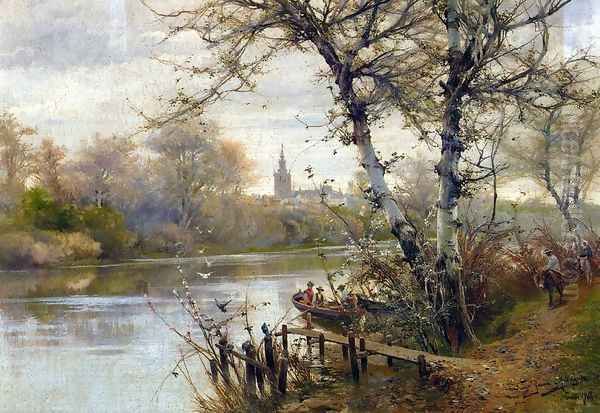
Las ciudades españolas y los naranjos (Spanish Cities and Orange Trees): An oil on wood piece (27.5 x 41 cm), the title suggests a composition blending urban elements with the iconic orange trees so characteristic of Seville and other Spanish cities, perhaps focusing on the integration of nature within the urban fabric.
Sanlúcar de Barrameda (1912): Paintings with this title would depict the coastal town at the mouth of the Guadalquivir River, known for its unique light and connection to the sea and the river, offering a different type of Andalusian landscape compared to the inland scenes of Seville or Alcalá.
These works, among many others, solidify his reputation as a dedicated chronicler of Andalusian scenery.
The Alcalá de Guadaíra Circle
Manuel García y Rodríguez is considered an important member of the Alcalá de Guadaíra school of landscape painting. This wasn't necessarily a formal institution but rather a loose group of artists drawn to the picturesque landscapes along the Guadaíra River, near Seville. The area, particularly around the town of Alcalá de Guadaíra with its medieval castle and river mills, offered ideal subjects for plein air painting and realistic landscape depiction.
Artists associated with this circle, including García y Rodríguez, were known for their focus on the local scenery, their realistic approach, and their interest in capturing the specific light and atmosphere of the region. While he maintained his individual style, his association with this group places him within a significant regional movement in Spanish landscape painting during the late 19th and early 20th centuries. His work shares thematic similarities with others painting in the area, such as Emilio Sánchez Perrier, although sources suggest García y Rodríguez often pursued a more detailed and precise realism compared to the sometimes more atmospheric approach of Sánchez Perrier.
Context and Connections: Influences and Peers
While specific teachers are not documented, García y Rodríguez's work clearly shows awareness of broader artistic trends. His realistic style and focus on landscape connect him to the legacy of the French Barbizon School, which championed direct observation of nature and realistic depiction over idealized Neoclassical landscapes. Key figures of the Barbizon School, such as Jean-Baptiste-Camille Corot, Jean-François Millet, Théodore Rousseau, and Charles-François Daubigny, had a profound impact on landscape painting across Europe, and their influence can be discerned in the approach of many Spanish painters of García y Rodríguez's generation.
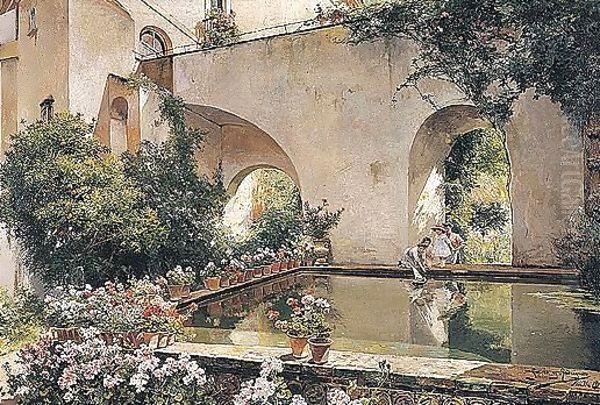
Within Spain, García y Rodríguez was contemporary with several major artists, although their styles and subjects often differed. Joaquín Sorolla, famed for his luminous beach scenes and mastery of light, represents a different facet of Spanish realism and Luminism. Ignacio Zuloaga focused on more dramatic, often darker, depictions of Spanish identity and tradition. In Catalonia, Santiago Rusiñol and Ramon Casas were key figures in Modernisme, often depicting urban life and gardens with a different sensibility.
More closely aligned in terms of landscape focus was Aureliano de Beruete, a prominent landscape painter based primarily in Madrid, known for his depictions of Castile. García y Rodríguez's dedication to Andalusia provides a regional counterpoint to Beruete's work. Other notable Spanish contemporaries include Ignacio Pinazo Camarlench, active in Valencia. While perhaps not direct influences, the towering figures of earlier Spanish art, like the master realist Diego Velázquez or the revolutionary Francisco Goya, formed the backdrop against which all later Spanish artists worked. The mention in sources of an influence from Barcelona painters, though unspecified, suggests an awareness of artistic developments in other parts of Spain. García y Rodríguez navigated these currents, developing his distinct focus on the detailed, sunlit landscapes of his native Andalusia.
Recognition at Home and Abroad
Manuel García y Rodríguez achieved considerable success and recognition during his lifetime. He was a regular participant in Spain's prestigious National Exhibition of Fine Arts (Exposición Nacional de Bellas Artes), where his work received critical acclaim and numerous awards. This participation placed him firmly within the mainstream of the Spanish art world.
His appealing style and subject matter also found favour with the public and collectors, particularly the middle class who appreciated his recognizable and beautifully rendered scenes of Andalusia. His paintings were frequently reproduced, appearing as illustrations or even covers for magazines, broadening his visibility beyond traditional art circles.
His reputation extended beyond Spain's borders. His works were included in exhibitions held in other European cities and notably in the United States, indicating an international appreciation for his talent. The presence of his works in major auction houses like Christie's, both historically and currently, attests to his enduring market value and collectability. Furthermore, his paintings are held in museum collections, including the prestigious Seville Museum of Fine Arts (Museo de Bellas Artes de Sevilla), ensuring his legacy is preserved for future generations.
Enduring Legacy
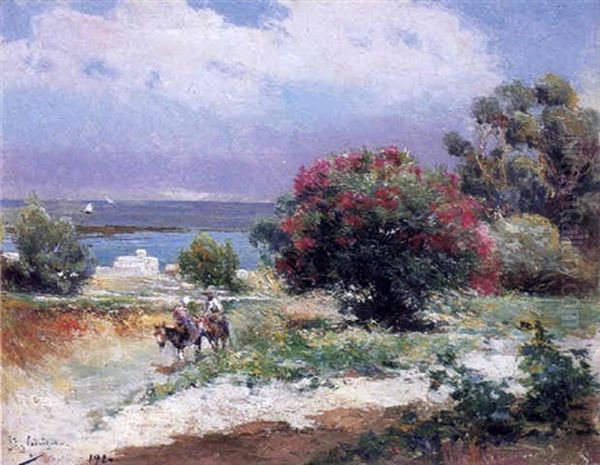
Manuel García y Rodríguez passed away in 1925, leaving behind a substantial body of work dedicated almost entirely to the landscapes of his beloved Andalusia. His legacy rests on his position as one of the foremost painters of the Alcalá de Guadaíra school and a key representative of Spanish landscape realism at the turn of the 20th century.
His paintings offer more than just topographical accuracy; they convey a deep affection for the region, capturing its unique light, colours, and atmosphere. Through his meticulous technique and keen eye for detail, he preserved views of Seville, the Guadalquivir, and the surrounding countryside, offering valuable historical and artistic insights into the Andalusia of his time. His consistent style and thematic focus, maintained throughout his career, underscore his dedication to his chosen subject.
Conclusion
Manuel García y Rodríguez remains a respected and important figure in the history of Spanish art. As a master of realistic landscape painting, he dedicated his artistic life to capturing the essence of Andalusia. His detailed brushwork, sensitive handling of light, and evocative depictions of Seville and its environs continue to be admired. By distinguishing him from namesakes and focusing on his specific contributions as a painter, we appreciate his unique role in chronicling the beauty of southern Spain through a lens of meticulous realism and profound regional affection. His work endures as a testament to the timeless allure of the Andalusian landscape.